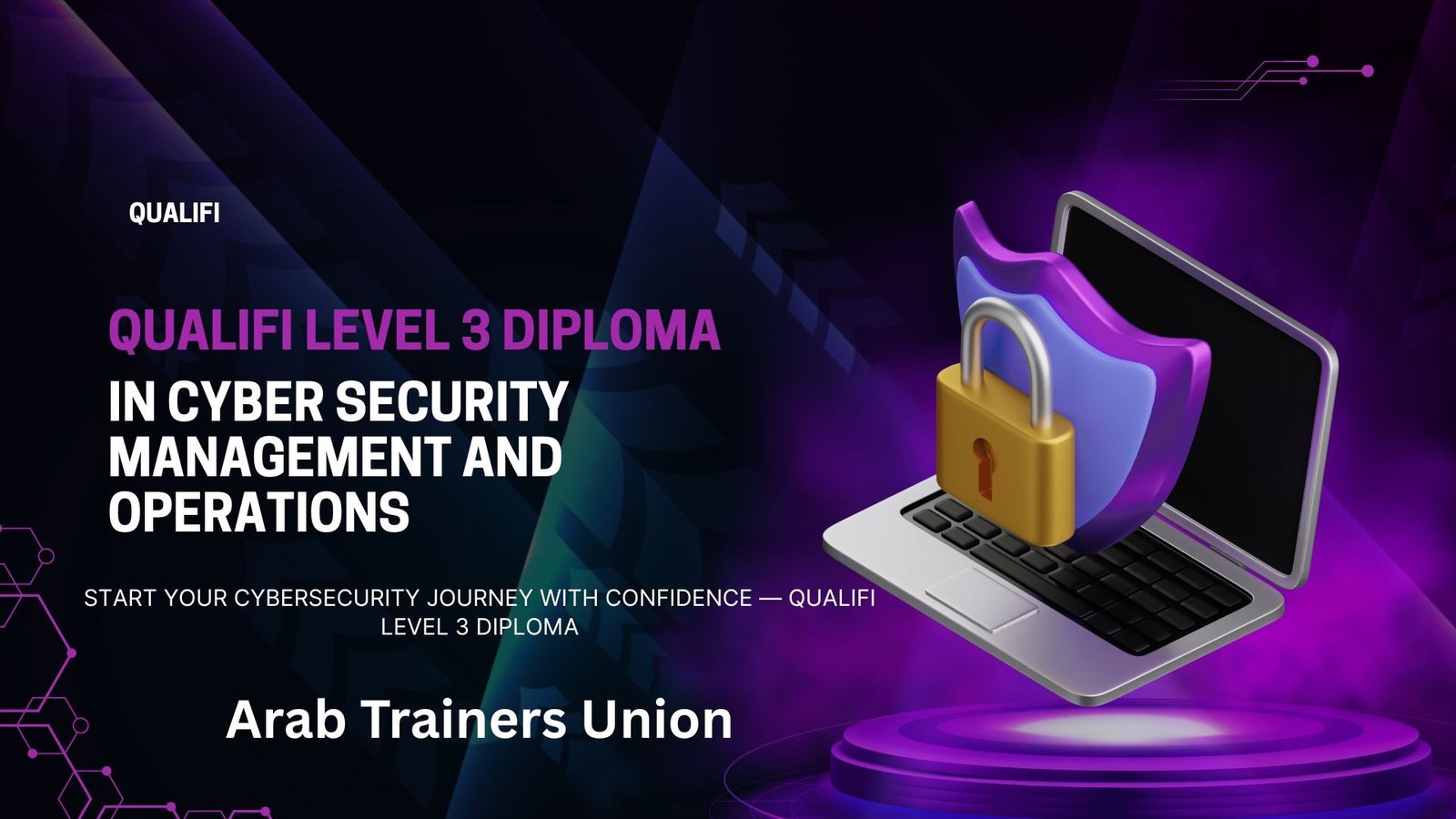Qualifi Level 3 Diploma in Cyber Security Management and Operations
Course Title
Qualifi Level 3 Diploma in Cyber Security Management and Operations
Course Level
Course Credits
Study Method
Start Date
Course Duration
Awarded By
Course Description
The qualification has been created to develop those learners who are looking to choose, or already have chosen, a career in a business-related sector. It is envisaged that this programme will encourage both academic and professional development so that your learners move forward to realise not just their own potential but also that of organisations across a broad range of sectors. The rationale of the programme is to provide a career path for learners who wish to develop their core capabilities within the cyber security sector.
Course Content
Mandatory
Threat and Risk: Expecting the Unexpected
In this unit the learner will be look at various case studies in recent cyber-attacks on business organisations, public sector agencies and individual victims. They will then conduct analysis will then into the motivations of malicious hackers. This analysis will include basic geopolitical learning, as it relates to the cyber domain, as well as identifying how and why different industry sectors (including Banking and Finance) are particularly vulnerable.
Towards the end of the unit the learner will look at the types of hacking undertaken: White Hat hacking, Grey Hat hacking and Black Hat Hacking. Learners will be introduced to concepts such as ‘Threat’, ‘’Risk’, ‘Security Engineering’, ‘Cyber Threat Intelligence’ and ‘Cyber Resilience’.
Network Architecture, Communications and Protocols
In this unit the learner will look at IT networks and the various components and architecture as they relate to the topic of ‘cyber security’. This unit will break down the processes involved in IT networkbased communications and protocols and introduce and explain the OSI Model of computer communication and interoperability. One dedicated lesson will address: ‘How does the internet work?’ The learner will develop an understanding of the more popular and destructive methods used to carry out attacks including case studies in Botnets, Trojans and other Malware. Key information security principles – including the ‘CIA Triad’ and ‘Access Controls’ – are introduced and explained within a business organisational context.
This unit prepares learners to participate in the often-technical aspects of change management and configuration management committees and task groups that might be responsible for aspects of organisational cyber security. A range of industry case studies will be used throughout this unit in order to upskill the learner and provide an ‘helicopter’ view of network architecture, communications and underpinning protocols.
Mobile Device and Data Risks
Mobile devices pose a significant threat to an organisation’s state of cyber security. The number of smartphone users is around 2.5 billion at time of writing. On any single day, hundreds of millions of employees travel and commute and are mobile-enabled in terms of conducting their business and exposing valuable data to enhanced risk.
In this unit the learner will learn how mobile devices become attached to radio and telecommunications networks. How are they connected to the internet and what types of tool can be utilised by malicious attackers to harm individuals and business organisations?
The second half of this unit will introduce and explain significant favoured ways by the cyber security and mobile device industry used to protect mobile devices and data. Key approaches and tools such as data encryption, storage back-up, and other security measures will be investigated and recommended.
Moreover, Cisco estimates that 50 billion items will be connected to the internet by 2020. The Internet of Things (IoT) are cyber-enabled gadgets and devices – often used for leisure or household purposes – that unintentionally expose our home or business networks to additional risk because they become attached to the very same communications channels and signals. In response, malicious hackers are developing customised malware to attack such devices. What are the IoT vulnerabilities and how can they be patched or remediated, if at all? Analysis or consideration of the IoT will therefore form an important part of this unit.
Investigations and Incident Response
Investigations and Incident Response are different operations within the discipline of Information Security. However, they are closely related.
In this unit the learner will investigative techniques used to identify and investigate suspicious computer incidents. Learners will learn about the essential roles, responsibilities, tasks and subdisciplines within Incident Response. The learner will become familiar with the essential functions of Computer Emergency Response Teams (CERTS) and Incident Response (IR), Disaster Recovery Planning and Business Continuity Management (BCM), including documentation and review.
The learner will also explore investigations as a discipline and how the approaches and concepts of investigations (such as Forensics and Seizure) can be applied to an ICT incident. All unit sections will include descriptions and suggestions about relevant SIEM, Incident Response and Investigations tools. Many of these monitoring and recovery tools can be used to conduct workplace investigations in an ethical and professional manner. A range of case studies for business and public sector/government organisations will be used throughout this unit.
Solutions: Future-Proofing your Business
In this unit the learner will bring together your knowledge and understanding from the previous units. This unit focuses on scoping the threats and vulnerabilities to companies, employees and customers across their entire network space, including LANs, WANs, Cloud Storage, mobile devices and any IoT-enabled devices.
The learner will apply the OSI model to understand the various opportunities that business organisations can take to protect their people, processes and technologies. The learner will then begin the task of developing an holistic security plan for a large-scale business organisation.
Learners will explore various Security Engineering Standards and Threat Assessment approaches before devising and generating their own organisational security plan based on a formal risk assessment. This plan should be comprehensive, relevant and suitable to be applied by a multinational organisational Executive Board.
EU GDPR and Data Security
The European Union (EU) impacted most global enterprises in May 2016 when it passed the General Data Protection Regulation, entering into effect two years later (May 25, 2018). All companies— including international firms—doing business with individuals located in EU member states must comply with the regulation’s far-reaching provisions. Moreover, many significant trading nations, including the UK, are emulating the EU GDPR to pass their own upgraded data protection regulations for citizens. Failure to act quickly to prepare for the regulation could have serious consequences—to an organisation’s bottom line, customer relationships and reputation.
In this unit the learner will develop an understanding of EU GDPR legal provisions and how these have been interpreted and implemented at a national level. Learners will have the opportunity to use your understanding to create an in-house EU GDPR audit toolkit.
Progression and Links to other QUALIFI Programmes
Completing the QUALIFI Level 3 Diploma in Cyber Security Management and Operations will allow learners to progress to:
- the QUALIFI Level 4 Diploma in Cyber Security, or
- directly into employment in an associated profession.
Study Method
The QUALIFI Level 3 Diploma in Cyber Security Management and Operations is studied through Education Global Network’s leading colleges Distance or in-class learning. You will be provided instant access to study materials, dedicated one-on-one tutoring and assignment feedback through qualified tutors.
Course Fees
Please get in touch with us to get the most up-to-date course fee for the QUALIFI Level 3 Diploma in Cyber Security Management and Operations. Monthly Installment is available.

Entry Requirements
The qualifications have been designed to be accessible without artificial barriers that restrict access and progression.
Your existing educational qualifications and work experience will be directly taken into account, allowing for module exemptions whenever possible. Please make an enquiry Now.
Apply now to embark on your academic journey and unlock endless opportunities! Join our vibrant community of scholars and leaders, and pursue your passion with an internationally recognised British qualification.
Click Apply Now to start your application for the QUALIFI Level 3 Diploma in Cyber Security Management and Operations programme today.

